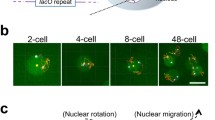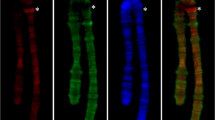Abstract
The looped organization of the eukaryotic genome mediated by a skeletal framework of non-histone proteins is conserved throughout the cell cycle. The radial loop/scaffold model envisages that the higher order architecture of metaphase chromosomes relies on an axial structure around which looped DNA domains are radially arranged through stable attachment sites. In this light we investigated the relationship between the looped organization and overall morphology of chromosomes. In developing Xenopus laevis embryos at gastrulation, the bulk of the loops associated with histone-depleted nuclei exhibit a significant size increase, as visualized by fluorescence microscopy of the fully extended DNA halo surrounding high salt treated, ethidium bromide stained nuclei. This implies a reduction in the number of looped domains anchored to the supporting nucleoskeletal structure. The cytological analysis of metaphase plates from acetic acid fixed whole embryos, carried out in the absence of drugs inducing chromosome condensation, reveals a progressive thickening and shortening of metaphase chromosomes during development. We interpret these findings as a strong indication that the size and number of DNA loops influence the thickness and length of the chromosomes, respectively. The quantitative analysis of chromosome length distributions at different developmental stages suggests that the shortening is timed differently in different embryonic cells.
Similar content being viewed by others
References
Baltzer F (1909) Die Chromosomen von Strongylocentrotus lividus und Echinus microtuberculatus. Arch Zellforsch 2: 549–632
Baumgartner M, Dutrillaux B, Lemieux N, Lilienbaum A, Paulin D, Viegas-Pequignot E (1991) Genes occupy a fixed and symmetrical position on sister chromatids. Cell 64: 761–766
Berezney R (1984) Organization and functions of the nuclear matrix. In: HnilicaLS (ed) Chromosomal non-histone proteins, vol IV, CRC Press, Boca Raton, Florida, pp 119–180
Blumenthal AB, Kriegstein HJ, Hogness DS (1974) The units of DNA replication in Drosophila melanogaster chromosomes. Cold Spring Harbor Symp Quant Biol 38: 205–224
Boy de la Tour E, Laemmli UK (1988) The metaphase scaffold is helically folded: sister chromatids have predominantly opposite helical handedness. Cell 55: 937–944
Briggs R (1979) Genetics of cell type determination. Int Rev Cytol [Suppl] 9: 107–127
Buongiorno-Nardelli M, Micheli G, Carrì MT, Marilley M (1982) A relationship between replicon size and supercoiled loops domains in the eukaryotic genome. Nature 298: 100–102
Callan HG (1972) Replication of DNA in the chromosomes of eukaryotes. Philos Trans R Soc Lond [Biol] 181: 19–41
Carrì MT, Micheli G, Graziano E, Pace T, Buongiorno-Nardelli M (1986) The relationship between chromosomal origins of replication and the nuclear matrix during the cell cycle. Exp Cell Res 164: 426–436
Cook PR (1989) The nucleoskeleton and the topology of transcription. Eur J Biochem 185: 487–501
Cook PR (1991) The nucleoskeleton and the topology of replication. Cell, 66: 627–635
Cook PR, Brazell IA (1978) Spectrofluorometric measurement of the binding of ethidium to superhelical DNA from cell nuclei. Eur J Biochem 84: 465–477
Cook PR, Brazell IA, Jost E (1976) Characterization of nuclear structures containing superhelical DNA. J Cell Sci 22: 303–324
Di Berardino MA (1962) The karyotype of Rana pipiens and investigation of its stability during embryonic differentiation. Dev Biol 5: 101–126
Dijkwel PA, Wenink PW, Poddighe J (1986) Permanent attachment of replication origins to the nuclear matrix in BHK-cells. Nucleic Acids Res 14: 3241–3249
Dijkwel PA, Vaughn JP, Hamlin JL (1991) Mapping of replication initiation sites in mammalian genomes by two-dimensional gel analysis: stabilization and enrichment of replication intermediates by isolation on the nuclear matrix. Mol Cell Biol 11: 3850–3859
Dingman CW (1974) Bidirectional chromosome replication: some topological considerations. J Theor Biol 38: 187–195
Parnshaw WC (1988) Mitotic chromosome structure. BioEssays 9: 147–150
Erdmann RM (1909) Experimentelle Untersuchung der Massenverhältnisse von Plasma, Kern und Chromosomen in dem sich entwickelnden Seeigelei. Arch Zellforsch 2: 76–136
Pilipski J, Leblanc J, Youdale T, Sikorska M, Walker PR (1990) Periodicity of DNA folding in higher order chromatin structure. EMBO J 9: 1319–1323
Frankhauser G (1934) Cytological studies on egg fragments of the salamander Triton. V. Chromosome number and chromosome individuality in the cleavage mitoses of merogonic fragments. J Exp Zool 68: 1–57
Gasser SM (1991) Replication origins, factors and attachment sites. Curr opin Cell Biol 3: 407–413
Gasser SM, Amati BB, Cardenas ME, Hofmann JF-X (1989) Studies on scaffold attachment sites and their relation to genome function. Int Rev Cytol 119: 57–96
Gurdon JB (1974) The control of gene expression in animal development. Harvard University Press, Cambridge Mass, USA
Jack RS, Eggert H (1992) The elusive nuclear matrix. Eur J Biochem 209: 503–509
Jackson DA (1986) Nucleoids. In: MacGillivrayAJ, BirnieGD (eds) Nuclear substructures — Isolation and characterization. Butterworths, London, pp 14–33
Jackson DA, Dickinson P, Cook PR (1990) The size of chromatin loops in HeLa cells. EMBO J 9: 567–571
Keppel F (1986) Transcribed human ribosomal RNA genes are attached to the nuclear matrix J Mol Biol 187: 15–21
King TJ (1979) Prologue: nuclear transplantation in Amphibia. Int Rev Cytol [Suppl] 9: 101–106
Laemmli UK, Cheng SM, Adolph KW, Paulson JR, Brown JA, Baumbach WR (1978) Metaphase chromosome structure: the role of non-histone proteins. Cold Spring Harbor Symp Quant Biol 42: 351–360
Laemmli UK, Käs E, Poljak L, Adachi Y (1992) Scaffold-associated regions: cis-acting determinants of chromatin structural loops and functional domains. Curr Opin Genet Dev 2: 275–285
Lebkowski JS, Laemmli UK (1982) Evidence for two leves of DNA folding in histone-depleted HeLa interphase nuclei. J Mol Biol 156: 309–324
Marilley M, Gassend-Bonnet G (1989) Supercoiled loop organization of genomic DNA: a close relationship between loop domains, expression units and replicon organization in rDNA from Xenopus laevis. Exp Cell Res 180: 475–489
Mikamo K, Witschi E (1966) The mitotic chromosomes in Xenopus laevis (Daudin): normal, sex reversed and female WW. Cytogenetics 2: 1–19
Nelson WG, Pienta KJ, Barrack ER, Coffey D (1986) The role of the nuclear matrix in the organization and function of DNA. Annu Rev Biophys Chem 15: 457–475
Newport J, Kirschner M (1982a) A major developmental transition in early Xenopus embryos: I. Characterization and timing of cellular changes at the midblastula stage. Cell 30: 675–686
Newport J, Kirschner M (1982b) A major developmental transition in early Xenopus embryos: II. Control of the onset of transcription. Cell 30: 687–696
Nieuwkoop PD, Faber J (1967) Normal tables of Xenopus laevis. North Holland, Amsterdam
Paulson J (1988) Scaffolding and radial loops: the structural organization of metaphase chromosomes. In: AdolphKW (ed) Chromosomes and chromatin. CRC Press, Boca Raton, Florida, pp 3–36
Rattner JB, Lin CC (1985) Radial loops and helical coils coexist in metaphase chromosomes. Cell 42: 291–296
Razin SV, Mantieva VL, Georgiev GP (1979) The similarity of DNA sequences remaining bound to scaffold upon nuclease treatment of interphase nuclei and metaphase chromosomes. Nucleic Acids Res 7: 1713–1735
Sharma AK, Sharma A (1980) Chromosome techniques: theory and practice, 3rd ed. Butterworths, London
Shiokawa K (1991) Gene expression from endogenous and exogenously-introduced DNAs in early embryogenesis of Xenopus laevis. Dev Growth Differ 33: 1–8
Shiokawa K, Misumi Y, Tashiro K, Nakakura N, Yamana K, Oh-uchida M (1989) Changes in the patterns of RNA synthesis in early embryogenesis of Xenopus laevis. Cell Differ Dev 28: 17–26
van der Velden HMW, van Willigen G, Wetzels RHW, Wanka F (1984) Attachment of origins of replication to the nuclear matrix and the chromosome scaffold. FEBS Lett 171: 13–16
Vogelstein B, Pardoll DM, Coffey DS (1980) Supercoiled loops and eukaryotic DNA replication. Cell 22: 79–85
Ward WS, Partin AW, Coffey DS (1989) DNA loop domains in mammalian spermatozoa. Chromosoma 98: 153–159
Yamazaki Yamamoto K, Yamazaki K, Kato Y (1980) Changes of chromosomes during the early neural development of a Japanese newt, Cynops pyrrhogaster. Dev Growth Differ 22: 79–92
Author information
Authors and Affiliations
Additional information
Communicated by: M. Trendelenburg
Rights and permissions
About this article
Cite this article
Micheli, G., Luzzatto, A.R.C., Carrì, M.T. et al. Chromosome length and DNA loop size during early embryonic development of Xenopus laevis . Chromosoma 102, 478–483 (1993). https://doi.org/10.1007/BF00357103
Received:
Revised:
Accepted:
Issue Date:
DOI: https://doi.org/10.1007/BF00357103




